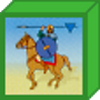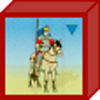Historical Background
Julius Caesar had conquered Gaul in just six years of campaigning (58-53 BC). However, in 52 BC most of the tribes of Gaul rose in a general revolt. Vercingetorix, a chieftain of the Averni, became overall commander of the rebel forces. Vercingetorix adopted an effective strategy of defending fortified towns in conjunction with scorchedearth tactics to deny the Romans supplies. In response, Caesar assaulted and captured Avaricum. Next he marched against the Gallic army at Gergovia, Vercingetorix’ hometown. Gergovia was situated on a particularly steep, high mount, making it a difficult position to attack. Caesar wanted to bring Vercingetorix into an open battle and stop the Gallic raids, so he set up a large camp for his six legions and built a small camp near the terraced approach to Gergovia. After sending a small force to make a feint away from the town, drawing off many of Vercingetorix’ troops, Caesar ordered his legions and allied troops to climb the hill and attack the enemy camps in front of the city. The Romans overcame the stone wall (represented by broken ground terrain hexes) at the base of the hill and moved forward to capture the enemy camps. The Gallic reinforcements hurried to the scene and drove the Roman troops back in fierce fighting. The barbarian advance was only checked by the 10th Legion that was held in reserve. The Romans reported the loss of 46 centurions and 700 troops of all nationalities killed, and another 6,000 wounded. Gergovia was the only major battle that Caesar lost during his conquest of Gaul. The following day, Caesar attempted to offer battle again but could not induce Vercingetorix to descend from his hilltop position. Having failed to achieve his objective, Caesar withdrew.
The stage is set. The battle lines are drawn and you are in command. The rest is history.

 |
 |
 |
 |
 |
 |
||||||||||||||
| 1 | 2 | 7 | 8 | 2 | 3 | ||||||||||||||
 |
 |
 |
 |
 |
 |
 |
 |
||||||||||||
| 2 | 2 | 8 | 2 | 2 | 2 | 2 | 3 |
War Council
Roman Army
• Leader: Julius Caesar
• 5 Command Cards ![]()
![]()
![]()
![]()
![]()
• Move First ![]()
Victory:
8 Banners
Special Rules
• The four Gallic reinforcement units and leader may be ordered to enter the battle by playing any leadership card. When ordered, set the units on any of the 5 hexes indicated on the Gallic right with Vercingetorix attached to one unit. These units may not move further on this turn but may battle.
• Then prior to the next Roman player’s turn, the Roman player must place his one reinforcing unit on any baseline hex in his left section. The unit now becomes part of the on-map Roman army, and may be ordered to move or battle.
• The Julius Caesar Rule and the Julian Legions rule are in effect.
• There are three Gallic camp hexes. When a Roman unit occupies an enemy camp hex at the start of his turn, remove the camp terrain tile hex. A Victory Banner is not gained for the first camp removed but one Victory Banner is collected for the second or third enemy camp hex removed. Once such a Victory banner is gained, it cannot be lost.
• If a Roman unit occupies a city wall hex, collect a Victory Banner. If the unit moves off or is eliminated, the banner is lost.
• When a Gallic unit occupies an enemy camp hex at the start of the turn, remove the camp terrain tile hex and collect a Victory Banner that cannot be lost. If a Gallic unit occupies a Roman large camp rampart hex, collect a Victory Banner. If the unit moves off or is eliminated, the banner is lost.
• The Gallic camp hexes and Gergovia city wall hexes (represented by rampart hexes) are considered to be on a hill.
• Gergovia City has scalable walls. Scalable walls terrain rule is in effect.
• The hill hexes adjacent to forest hexes are too steep to climb and are considered impassable terrain for units in adjacent forest hexes. Units on hill hexes adjacent to forest hexes may, however, move or retreat down from a hill hex onto a forest hex. A unit on a hill hex may not close combat against an enemy unit on a forest hex or visa versa.
